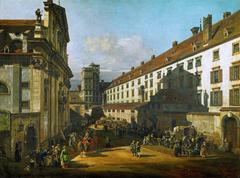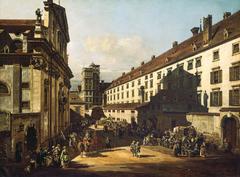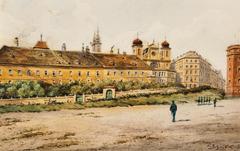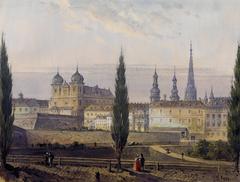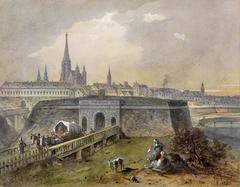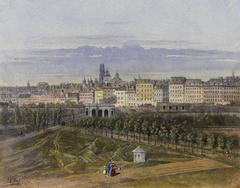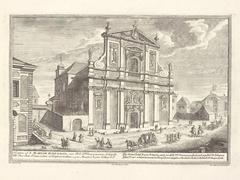
Dominican Church Vienna – Visiting Hours, Tickets, and Visitor Guide
Date: 15/06/2025
Introduction: History and Significance
The Dominican Church Vienna, or Dominikanerkirche (St. Maria Rotunda), stands as one of Vienna’s earliest and most impressive Baroque sanctuaries, situated in the heart of the Innere Stadt. With origins in the early 13th century, this church reflects a rich tapestry of Vienna’s religious, architectural, and cultural history. Founded upon invitation by Duke Leopold VI, the Dominican Order established its presence with a Romanesque church in 1237, later transformed through Gothic and Baroque periods. The current structure, consecrated in 1634 after devastation during the Turkish siege of 1529, is a vivid emblem of both Vienna’s resilience and the Catholic Church’s Counter-Reformation spirit. Today, the church impresses with its monumental façade, vibrant frescoes, and living spiritual community while remaining a hub for both worship and tourism. (Wikipedia: Dominican Church, Vienna) (Erzdiözese Wien) (TripHobo) (Vienna Info)
Whether you are drawn by faith, art, or history, this comprehensive guide will help you plan your visit with practical tips about opening hours, ticketing, accessibility, and more.
Table of Contents
- Introduction
- History: Foundations, Siege, and Baroque Rebirth
- Architecture & Art: Highlights and Restoration
- Cultural and Religious Importance
- Visiting Information: Hours, Tickets, Accessibility
- Visitor Tips and Nearby Attractions
- Frequently Asked Questions (FAQ)
- Visuals and Interactive Media Suggestions
- Conclusion
- Sources
History: Foundations, Siege, and Baroque Rebirth
Early Foundations and Medieval Growth
The Dominican Order arrived in Vienna in the early 13th century, receiving land for their monastery and church, completed in 1237 in the Romanesque style. Over the late Middle Ages, the church expanded and was rebuilt in Gothic fashion, reflecting Vienna’s growing spiritual and political prominence. (Erzdiözese Wien)
Turmoil and Decline
The Turkish siege of 1529 led to significant destruction. Much of the Gothic church was dismantled to reinforce the city’s defenses, marking a period of decline for the Dominican complex.
Baroque Transformation
In the early 17th century, Emperor Ferdinand II led a dramatic Baroque reconstruction as part of the Catholic Counter-Reformation. The current Dominikanerkirche was consecrated in 1634, becoming one of the earliest Baroque churches north of the Alps, distinguished by its grand design and ornate décor. (TripHobo)
Later Enhancements
The 19th century saw the addition of Romantic-era altar paintings and a new organ in 1896, further enriching the church’s liturgical and cultural life.
Modern Recognition
In 1927, the church was elevated to the status of Basilica minor by Pope Pius XI, underscoring its lasting religious and cultural significance.
Architecture & Art: Highlights and Restoration
Exterior: Baroque Grandeur
The church’s façade is a commanding example of early Baroque architecture, with its symmetrical layout, classical columns, and twin towers capped by onion domes. The portal features sculptural reliefs and inscriptions, and statues of Dominican saints, including St. Catherine of Siena and St. Rose of Lima, highlight its Marian dedication. (Wikipedia: Dominican Church, Vienna)
Interior: Light, Space, and Splendor
Inside, a luminous nave extends toward a magnificent high altar. Six side chapels, each dedicated to a Dominican saint, line the nave. The barrel-vaulted ceiling and dome are adorned with vibrant frescoes depicting scenes from the life of the Virgin Mary, executed in the Italian Baroque style. The elaborate stucco and marble work further enhance the sense of grandeur and transcendence. (TripHobo)
Restoration and Preservation
Recent restorations (2020–2022) have ensured the preservation of the church’s frescoes, stucco, and masonry, maintaining both its artistic integrity and spiritual atmosphere. (Erzdiözese Wien)
Cultural and Religious Importance
Liturgical Life and Community
The Dominican Church is an active parish and a minor basilica, with Masses, Marian feasts, and special events honoring Dominican saints. Its role during the Counter-Reformation and ongoing Marian devotion are reflected in its art and liturgy. (Wikipedia: Dominican Church, Vienna)
Musical Heritage
The church’s organ, built in 1895–1896 and renovated in 1991, supports a rich musical tradition, including concerts and services that highlight the church’s acoustics and spiritual vitality.
Symbol of Resilience
Surviving sieges, fires, and centuries of change, the church is a symbol of Catholic endurance and renewal in Vienna.
Visiting Information: Hours, Tickets, Accessibility
Location and Directions
- Address: Postgasse 4, 1010 Wien, Austria
- Public Transport: U-Bahn Schwedenplatz (U1, U4) and Stubentor (U3) are the nearest stations. Tram lines 1, 2, and D also stop nearby. The church is a short walk from Stephansplatz and the Stadtpark. (Vienna Info)
Opening Hours
- Monday to Saturday: 9:00 AM – 6:00 PM
- Sunday and public holidays: 10:00 AM – 6:00 PM
- Check the official website for updates during holidays or special events.
Tickets and Admission
- Entry: Free of charge
- Donations: Welcomed to support preservation
Accessibility
- Fully wheelchair accessible with ramps at the main entrance
- Assistance available upon request
Guided Tours
- Available by prior arrangement through the parish or Vienna tourist office
- Self-guided tours via apps (e.g., GPSmyCity) and on-site informational plaques (GPSmyCity)
Facilities
- Restrooms available (may be in adjacent buildings)
- The church is not heated in winter—dress warmly
- No on-site café, but many options nearby
Visitor Tips and Nearby Attractions
- Best times: Early morning or late afternoon for quiet reflection and optimal lighting
- Dress code: Modest attire is appropriate in this active place of worship
- Photography: Permitted; avoid flash, especially during services
- Events: Check calendar for concerts or special Masses
- Nearby attractions: Jesuit Church, Stephansdom, Museum of Applied Arts (MAK), Stadtpark
Frequently Asked Questions (FAQ)
Q: What are the Dominican Church Vienna visiting hours?
A: Generally 9:00–18:00 (Mon–Sat), 10:00–18:00 (Sun/Public Holidays), but check the official website for updates.
Q: Is there an entry fee or ticket required?
A: No, entry is free; donations are encouraged.
Q: Are guided tours available?
A: Yes, by prior arrangement or via self-guided apps.
Q: Is the church accessible for wheelchair users?
A: Yes, with ramps and assistance as needed.
Q: Can I take photographs inside?
A: Yes, but please be respectful, especially during services.
Q: Are there concerts or events at the church?
A: Regular concerts, special Masses, and cultural events are held—see the church’s website for details.
Visuals and Interactive Media Suggestions
- Exterior image: “Dominican Church Vienna Baroque façade”
- Interior image: “Dominican Church Vienna nave and altar”
- Ceiling frescoes: “Dominican Church Vienna Baroque ceiling frescoes”
- Interactive map: Location and nearby attractions
- Virtual tour or 360° view: Link to immersive media
Conclusion
The Dominican Church Vienna is a remarkable blend of Baroque artistry, spiritual tradition, and living community. Its free entry, generous visiting hours, and central location make it accessible to all. Whether you are a devotee, architecture lover, or casual traveler, the church’s serene atmosphere and artistic treasures promise a rewarding visit. Use resources like the Dominican Church Vienna official website and the Vienna Info portal to plan your trip and stay updated on events.
For those seeking deeper engagement, the Audiala app offers audio tours and interactive guides to enhance your exploration of Vienna’s religious and cultural gems.
References
- Wikipedia: Dominican Church, Vienna
- Erzdiözese Wien: Pfarren – Dominikanerkirche
- TripHobo: Dominican Church Vienna
- Vienna Info: St. Maria Rotunda (Dominican Church)
- Atlas Obscura: Dominikanerkirche (Dominican Church)
- Vienna.net: Churches of Vienna
- GPSmyCity: Dominican Church
